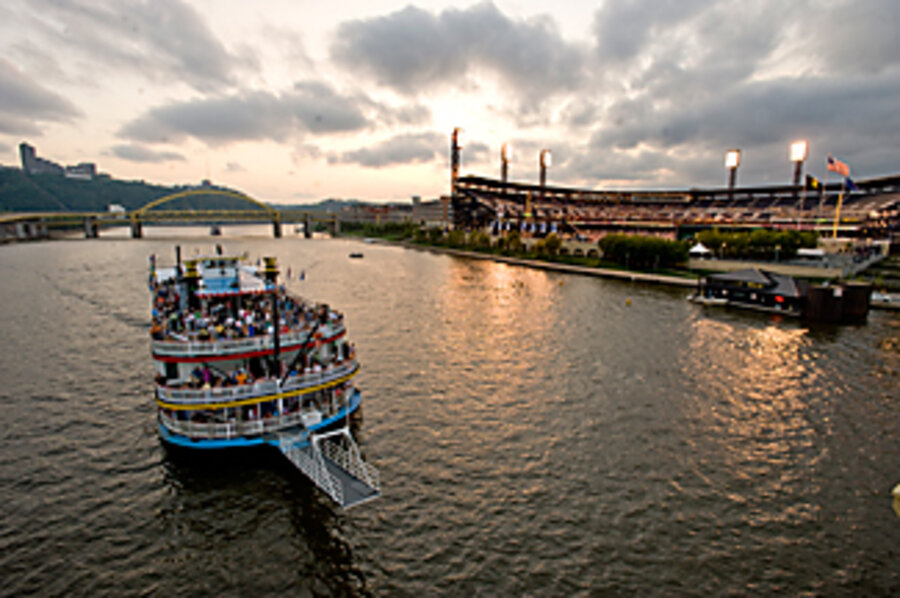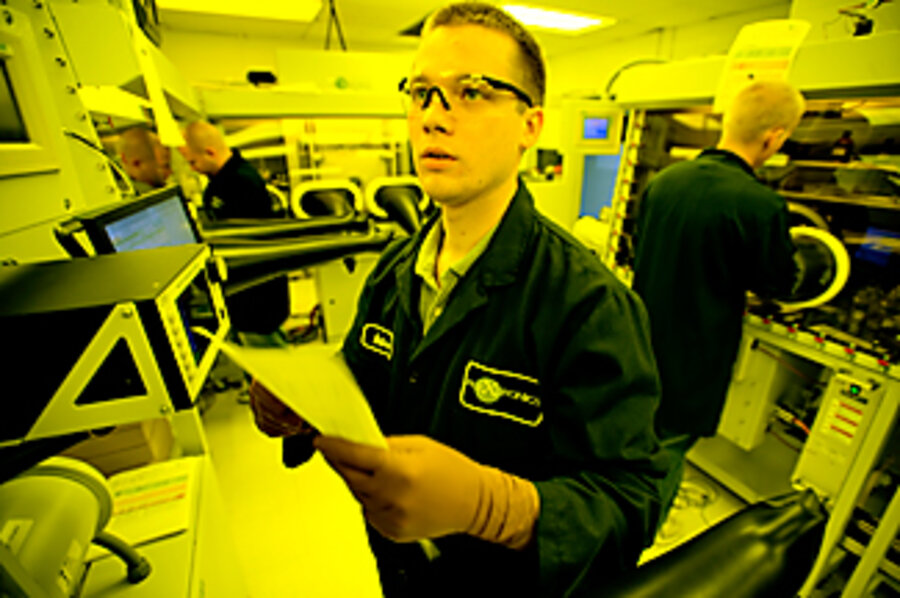At the G-20: Pittsburgh, the former 'Steel City,' has chance to shine
Loading...
| PITTSBURGH
When leaders from the Group of 20 nations meet here Thursday and Friday, they will find a city that has resurrected itself.
From the roof of the city's convention center – one of the G-20 venues – the dignitaries will look out on the Allegheny River and perhaps see kayakers on a waterway that used to be a dumping ground for industry. The leaders will enjoy canapés at the Phipps Conservatory, which was founded by a captain of industry but is now a green showplace. And if the visitors are able to walk the streets, they might hear jazz or Mozart – without a smoke-belching stack in sight.
Yes, even though the football team is called the Steelers, city officials want the world to know that steel is no longer Pittsburgh's raison d'être. The city with a sooty past is now exporting its medical technology. In rivers where waste used to abound, bass tournaments are now held.
Even as the United States struggles to exit the recession, the city boasts it has 25,000 unfilled jobs.
"People hear 'Pittsburgh,' and they think an older town; they think a dirty town," says Mayor Luke Ravenstahl, who proudly calls himself the youngest mayor of a major US city. "And, of course, that's not the case."
In a statement Sept. 8, President Obama explained why he wanted to hold the G-20 summit in Pittsburgh. "As a city that has transformed itself from the city of steel to a center for high-tech innovation – including green technology, education and training, and research and development – Pittsburgh will provide both a beautiful backdrop and a powerful example for our work."
Mr. Obama knows the city well, having visited it often last year during Pennsylvania's Democratic primary, which he lost to then-Sen. Hillary Rodham Clinton. While campaigning in Pittsburgh, Obama got a tour of the David L. Lawrence Convention Center, proudly touted by city officials for its LEED Gold certification from the US Green Building Council.
The facility, which will host G-20 meetings, uses natural light to illuminate much of the floor space. It can turn off the ventilation and let in outside air for about 50 days of the year.
Most of the building's components were built within 500 miles of Pittsburgh. Yet another green feature: a rooftop herb and vegetable garden, which is used by chefs preparing food for events in the facility.
"This building was intended to be an example and a catalyst for future green efforts in the region," writes Mary Conturo, executive director of the Sports & Exhibition Authority, which owns the center, in an e-mail.
On Thursday, the visiting dignitaries will dine at Phipps Conservatory and Botanical Gardens, an elegant greenhouse that melds glass artwork with exotic plant life.
It was built in 1893 by Henry Phipps, one of Andrew Carnegie's business partners. The facility is described by its executive director, Richard Piacentini, as "an excellent example of the old Victorian mind-set that there were no limits to the amount of resources we could use and the amount of pollution we could produce."
But today, this place is more about conservation with a drought-resistant lawn, natural heating and cooling, and the purchase of clean-energy offsets to account for all the power usage.
"We have tried to make the facility more sustainable within the historic nature of the building," Mr. Piacentini says.
Pittsburgh is developing an "emerging conscientiousness" on green issues, says architect Christine Brill, who works on urban design and landscape. For example, the city is starting to value open space, she says.
"The idea is to take back open industrial spaces and repurpose them – perhaps build greenways and trails so people can get around the city in a green kind of way," says Ms. Brill, a partner in Studio for Spatial Practice in Pittsburgh. "A lot of people have left the city. Greening might be a way to bring them back."
This is not to say Pittsburgh is the paragon of environmental correctness. According to a May report by the Brookings Institution in Washington, Pittsburgh ranked 34th among the 100 largest metropolitan areas in terms of its carbon footprint.
"While Pittsburgh is doing a lot of proactive things, is being creative with green-energy innovation and building a cleaner economy, you can't discount that their energy is coal-produced – and that elevates the carbon footprint of every household," says Mark Muro, a fellow for the Metropolitan Policy Program at Brookings.
Pittsburgh has a history of reinventing itself. In the 18th century, the city became known as the "Gateway to the West" because vessels could proceed down the Ohio River to the Mississippi, says Andrew Hannah, an adjunct professor of entrepreneurship at Carnegie Mellon University (CMU) in Pittsburgh.
"But the opening of the Erie Canal changed that, since goods from Europe no longer needed to go through Pittsburgh," he says.
Instead, in the early 1800s, Pittsburgh became an industrial center, thanks to Mr. Carnegie and Henry Clay Frick. Industrial giants such as Alcoa and US Steel flourished.
But in the 1980s, the US steel and manufacturing industries crashed. Large Pittsburgh-based companies, such as Westinghouse, stumbled into bankruptcy. The city had been the third-largest hub in the US for corporate headquarters, but after large employers such as Rockwell International moved out, it had fewer than 10 Fortune 500 headquarters.
In January 1983, unemployment in Pittsburgh was more than 18 percent, with some 212,400 people out of work.
"When the steel industry all but collapsed, we in this city had no choice but to reinvent ourselves," Mayor Ravenstahl says.
Now, Mr. Hannah is CEO of a company that's an example of the new Pittsburgh. Plextronics makes an ink that can efficiently conduct electricity. The chemical can be used to make inexpensive solar panels or extremely thin light fixtures.
A CMU professor, Richard McCullough, devised the ink and teamed up with Hannah seven years ago. Their company is in a research park that includes other companies spun off as a result of other professors' discoveries. "The universities today are driving industry," Hannah says.
This is not to say the "old Pittsburgh" has just gone away. One steel mill is still within the city limits. And 100,000 manufacturing jobs are still in the region, points out Dennis Yablonsky, CEO of the Allegheny Conference, which encourages economic development.
But Mr. Yablonsky sees the G-20 meetings as an opportunity to showcase the city's progress and maybe entice more businesses. "We hope to attract corporate executives and say to them, 'Look at Pittsburgh,' " he says.
While Pittsburgh may show that cities can recover, Yablonsky says, it can't be done overnight. "In Pittsburgh's case," he says, "it's a 30-year transformation story."
--
Related: G-20 summit: how Pittsburgh plans to handle protesters








